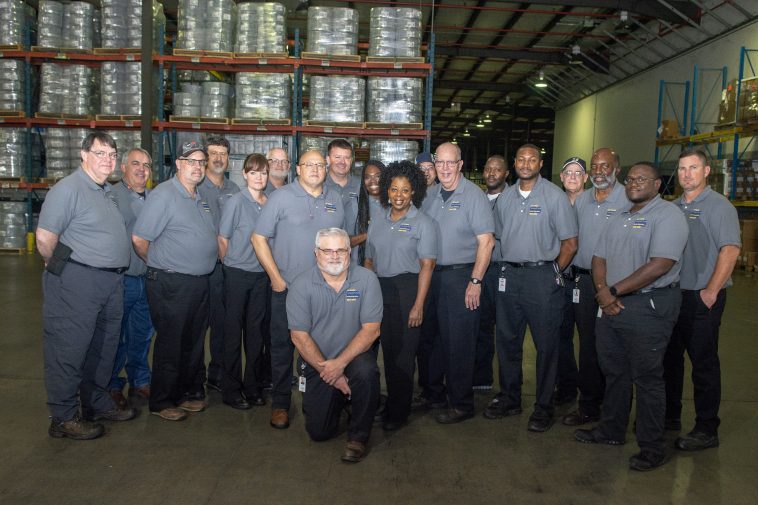Bridgestone Americas, Inc., a subsidiary of Bridgestone Corporation, the world’s largest tire and rubber company, announced its Bandag retread manufacturing plant in Oxford, North Carolina, celebrated 50 years of production on September 26, 2019. Bandag is Bridgestone’s business unit dedicated to the research, development, and manufacturing of premium retread tires. The Bandag plant in Oxford began manufacturing tread rubber and retreading materials in 1969 and continues to play a vital role in the local community today by employing nearly 200 people. Bridgestone hosted a lunch banquet and tour of the facility on September 26 to mark the important milestone.
“As we celebrate 50 years of manufacturing and production in Oxford, we are thankful for our devoted employees and their continued dedication to engineering products that are reliable, profitable, and sustainable. We also thank the Oxford community for its ongoing support,” says Mark Highland, plant manager, Bandag Oxford Plant, Bridgestone Americas Manufacturing Group (BAMG). “We are proud to manufacture quality retread rubber to help fleets run for thousands more miles and keep this country moving.”
OPERATION RETREAD
The 225,000-sq-ft facility and 135,000-sq-ft warehouse in Oxford are home to the company’s top-of-the-line production equipment, used to engineer precured rubber tread, cushion, and chemical materials that are used in the retreading process. An industry best practice for large commercial fleets1, retreading is the process of replacing the tread of a tire casing with a new tread rather than replacing the entire tire. The retreading process helps defer millions of tires from landfills annually, keeping them on the road instead of removing them from service after one use2. Through the reduced natural resource consumption that results from the retreading process, approximately 225 million gallons of oil are saved annually given that one retread saves 15 gallons of oil and approximately 15 million tires are retreaded each year3. Not only is retreading a sustainable business practice, it can help fleets lower tire costs to as low as 1.5 cents per mile4.
50 YEARS AND COUNTING
During its 50 years in operation, the Oxford plant has received several certifications for quality management and environmental responsibility including ISO 9001 and ISO 14001 certifications. The plant has also obtained the Carolina Star Certification, which recognizes employers who have implemented safety and health management systems to reduce employee injury rates and is patterned after the federal Occupational Safety and Health Administration Voluntary Protection Program. Year over year, Bandag employees in Oxford demonstrate Our Way to Serve, our global corporate social responsibility commitment. Employees give back to their community through partnerships and community volunteer projects with the United Way and the Granville Public Schools Reading Buddies program. In addition, the Oxford plant is a Vance Granville Community College scholarship sponsor.
“We are excited to celebrate the 50th anniversary of manufacturing and operations at the Bandag plant in Oxford,” says Eric Higgs, president, truck, bus and retread tires, US and Canada, Bridgestone Americas Tire Operations, LLC (BATO). “This achievement is a testament to the dedication of our employees in Oxford and their continued commitment to making mobility more efficient for commercial customers.”

Find out more about the Oxford Bandag retread manufacturing plant, visit www.bridgestoneamericas.com.
Disclaimers:
1. Source: Golden, J.S., Handfield, R., Daystar, J. and, J. Woodrooffe (2018). Retread Tires in the United States & Canada: An Analysis of the Economic & Environmental Benefits for Fleet Operators and the U.S. Government.
2. Source: Tire Retread & Repair Information Bureau: What is retreading?: https://www.retread.org/learn-more
3. Calculation based on 22 gallons of oil to manufacture a new tire vs. 7 gallons for a retread = 15 gallons of oil saved per retread. Overall, saves 225 million gallons of oil per year (15M retreaded tires each year X 15 gallons of oil saved per retread = 225M annually)
4. Source: North Carolina State University – https://scm.ncsu.edu/blog/2017/07/11/retreads-are-good-for-truckers-and-good-for-the-environment/ blog by Robert Handfield, July 11, 2017.
Photos courtesy of Bridgestone




